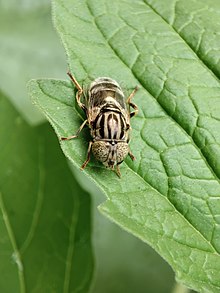| Eristalinus aeneus | |
|---|---|

| |
| male | |

| |
| female | |
| Conservation status | |
 Least Concern (IUCN 3.1) | |
| Scientific classification | |
| Domain: | Eukaryota |
| Kingdom: | Animalia |
| Phylum: | Arthropoda |
| Class: | Insecta |
| Order: | Diptera |
| Family: | Syrphidae |
| Genus: | Eristalinus |
| Species: | E. aeneus |
| Binomial name | |
| Eristalinus aeneus (Scopoli, 1763) | |
| Synonyms | |

Eristalinus aeneus (Scopoli, 1763), the common lagoon fly, is a fairly common species of syrphid fly observed throughout the United States and Europe. Hoverflies can remain nearly motionless in flight. The adults are also known as flower flies for they are commonly found on flowers, from which they get both energy-giving nectar and protein-rich pollen. The larvae occurs along shorelines in rock pools containing large amounts of decaying seaweed.
Description
For terms see Morphology of Diptera
The wing length is 6.5–9.25 mm. The eyes are patterned with obvious black spots. Tergites 2 and 3 are completely shiny. The thoracic dorsum has faint greyish stripes (in Southern Europe it has five strong grey stripes). In males the eyes meet on the frons. In females the eyes are bare on the lower half. The hind tibiae have a black ring after middle, and all tarsi with segments 2–4 darkened. The male genitalia are figured by Pérez-Bañón et al (2003). The larva is figured by Hartley (1961).
Distribution
The distribution of this species is cosmopolitan. inaturalist map
Biology

The habitat for this species is freshwater: coastal lagoons, ponds, slow-moving rivers, streams and irrigation ditches. The species is anthropophilic in southern Europe; towards the northern edge of its range there it is confined to coastal sites. The species flies very fast and low over ground vegetation, and feeds on yellow composites and white umbellifers: Aster, Berteroa incana, Cistus, Origanum, Salix repens, Taraxacum. The flight period is April to October, and it overwinters as an adult.
In the north, the larvae of E. aeneus occur in freshwater seapages and brackish rock pools on the sea coast, but elsewhere they occur in a variety of freshwater habitats, including in association with animal dung and in sewage farms.
References
- Aracil, A., Pérez, C., Rojo, S. & Campoy, A (2021). "Eristalinus aeneus". IUCN Red List of Threatened Species. 2021: e.T149166094A152281334. doi:10.2305/IUCN.UK.2021-3.RLTS.T149166094A152281334.en. Retrieved 21 October 2022.
{{cite journal}}: CS1 maint: multiple names: authors list (link) - Rotheray, G.E. (1993). "Colour Guide to Hoverfly Larvae (Diptera, Syrphidae) in Britain and Europe" (PDF). Diperists Digest. 9: 155.
- Skevington, Jeffrey H (2019). Field Guide to the Flower Flies of Northeastern North America. ISBN 9780691189406.
- Van Veen, M. (2004) Hoverflies of Northwest Europe: identification keys to the Syrphidae. 256 pages. KNNV Publishing, Utrecht.addendum
- Van der Goot, V.S. (1981) De zweefvliegen van Noordwest – Europa en Europees Rusland, in het bijzonder van de Benelux. KNNV, Uitgave no. 32: 275 pages. Amsterdam.
- Bei-Bienko, G.Y. & Steyskal, G.C. (1988) Keys to the Insects of the European Part of the USSR, Volume V: Diptera and Siphonaptera, Part I. Amerind Publishing Co., New Delhi. ISBN 81-205-0080-6.
- Coe, R.L. (1953) Diptera: Syrphidae. Archived 2018-10-04 at the Wayback Machine Handbks.ident.Br.insects, 10(1): 1–98. R.ent.Soc.London.
- Pérez-Bañón, C.; Rojo, S.; Ståhls, G. & Marcos-García, Mª A. (2003) Taxonomy of European Eristalinus (Diptera: Syrphidae) based on larval morphology and molecular data. Eur.J.Entomol., 100: 417–428.
- Hartley, J.C. (1961) A taxonomic account of the larvae of some British Syrphidae. Proc.zool.Soc.Lond.,136: 505–573.
- Peck, L.V. (1988) "Syrphidae". In: Soos, A. & Papp, L. (eds.) Catalogue of Palaearctic Diptera, 8: 11–230.
- Speight, M.C.D. (2011). "Species accounts of European Syrphidae (Diptera)" (PDF). Syrph the Net, the Database of European Syrphidae. 65: 285.
- de Buck, N. (1990) Bloembezoek en bestuivingsecologie van Zweefvliegen (Diptera, Syrphidae) in hetbijzonder voor België. Doc.Trav. IRSNB, no.60, 1–167.
External links
 Media related to Eristalinus aeneus at Wikimedia Commons
Media related to Eristalinus aeneus at Wikimedia Commons- External images